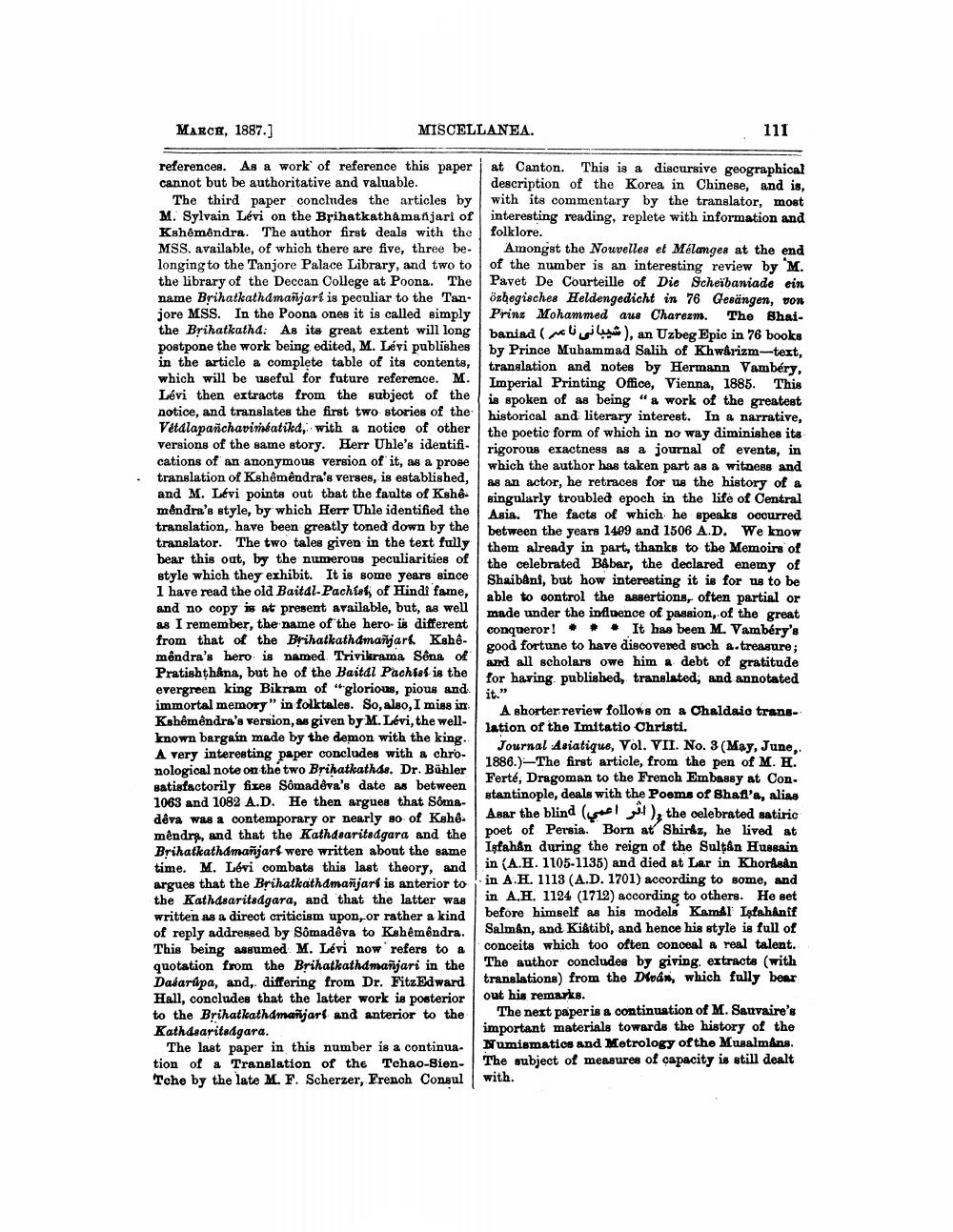________________
MARCH, 1887.)
MISCELLANEA.
111
references. As a work of reference this paper at Canton. This is a discursive geographical cannot but be authoritative and valuable. description of the Korea in Chinese, and is,
The third paper concludes the articles by with its commentary by the translator, most M. Sylvain Lévi on the Brihatkathamanjari of interesting reading, replete with information and Kshêmêndra. The author first deals with the folklore. MSS. available, of which there are five, three be- Amongst the Nouvelles et Mélanges at the end longing to the Tanjore Palace Library, and two to of the number is an interesting review by M. the library of the Deccan College at Poona. The Pavet De Courteille of Die Scheibaniade ein name Brihatkathamañjart is peculiar to the Tan öshegisches Heldengedicht in 76 Gesängen, von jore MSS. In the Poona ones it is called simply Prins Mohammed aus Charexm. The Bhai. the Brihatkatha: As its great extent will longbaniad ( w ), an Uzbeg Epic in 76 books postpone the work being, edited, M. Lévi publishes by Prince Muhammad Salih of Khwarizm-text, in the article a complete table of its contents,
translation and notes by Hermann Vambéry. which will be useful for future reference. M.
Imperial Printing Office, Vienna, 1885. This Lévi then extracts from the subject of the is spoken of as being "a work of the greatest notice, and translates the first two stories of the historical and literary interest. In a narrative, Vetalapanchavinkatikd, with a notice of other the poetic form of which in no way diminishes its versions of the same story. Herr Uhle's identifi- rigorous exactness as a journal of evente, in cations of an anonymous version of it, as a prose which the author has taken part as a witness and translation of Kshêmêndra's verses, is established,
as an actor, he retraces for us the history of a and M. Lévi points out that the faults of Kshe.
singularly troubled epoch in the life of Central mêndra's style, by which Herr Uhle identified the
Asia. The facts of which he speaks occurred translation, have been greatly toned down by the
between the years 1409 and 1506 A.D. We know translator. The two tales given in the text fully
them already in part, thanks to the Memoirs of bear this out, by the numerous peculiarities of
the celebrated BAbar, the declared enemy of style which they exhibit. It is some years since
Shaibani, but how interesting it is for us to be 1 have read the ola Baital-Pachish, of Hindi fame,
able to control the assertions, often partial or and no copy is at present available, but, as well
made under the influence of passion, of the great as I remember, the name of the hero is different
conqueror! # # # It has been M. Vambéry's from that of the Brihatkathamañjark Kshê.
good fortune to have discovered such a treasure; mêndra's hero is named Trivikrama Sêna of
and all scholars owe him a debt of gratitude Pratishthana, but he of the Baital Pachies is the
the for having published, translated, and annotated evergreen king Bikram of "glorious, pious and. immortal memory" in folktales. So, also, I miss in A shorter review follows on a Chaldaio transKshêmêndra's version, as given by M. Lévi, the well
lation of the Imitatio Christi. known bargain made by the demon with the king.
Journal Asiatique, Vol. VII. No. 3 (May, June, A very interesting paper concludes with a chro
1886.)-The first article, from the pen of M. H. nological note on the two Brihatkathas. Dr. Bühler
Ferté, Dragoman to the French Embassy at Con. satisfactorily fixes Sômadêva's date as between
stantinople, deals with the Poems of Shafl'a, alias 1063 and 1082 A.D. He then argues that Sôma
Asar the blind (usual w ), the celebrated satiric deva was a contemporary or nearly so of Kehê. mêndra, and that the Kathdsaritsagara and the
poet of Persia. Born at Shiraz, he lived at Brihatkathamañjarf were written about the same
Iạfahân during the reign of the Sultan Hussain tima M. Lavi combate this last theory and in (A.H. 1105-1135) and died at Lar in Khortaan argues that the Brihatkathamañjarf is anterior to
in A.H. 1113 (A.D. 1701) according to some, and the Kathasaritadgara, and that the latter was in A.H. 1124 (1712) according to others. He set written as a direct criticism upon, or rather a kind
before himself as his models Kamal Ixtahanif of reply addressed by Sômadêva to Kshêmêndra.
Salman, and Ki&tibi, and hence his style is full of This being assumed M. Lévi now refers to a conceits which too often conceal a real talent. quotation from the Brihatkathamañjari in the The author concludes by giving, extracts (with Dasartipa, and differing from Dr. FitzEdward
translations) from the Divan, which fully bear Hall, concludes that the latter work is posterior
out his remarks. to the Brihatkathamañjart and anterior to the The next paper is a continuation of M. Sauvaire's Kathdsaritadgara.
important materials towards the history of the The last paper in this number is a continua Numismatics and Metrology of the Musalmans. tion of a Translation of the Tchao-Bien
The subject of measures of capacity is still dealt Tche by the late M. F. Scherzer, French Consul with.




